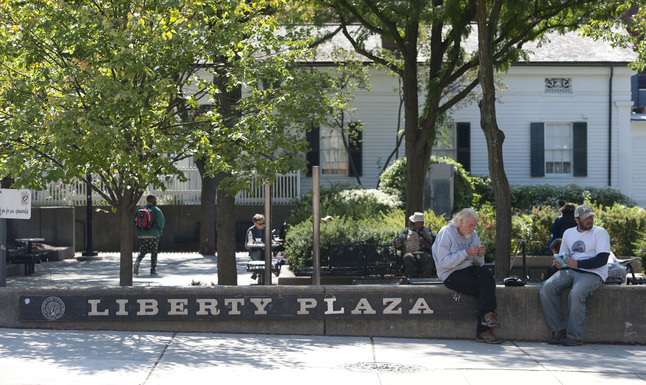
A redesign of Liberty Plaza's interior might not be as important as rethinking what kind of foot traffic generators are situated around the park, according to experts.
Courtney Sacco | AnnArbor.com
Previous report: Liberty Plaza: City leaders look for ways to end crime, vagrancy issues at park
While Ann Arbor city officials begin to consider a redesign of Liberty Plaza, experts point to the areas outside the park’s boundaries as catalysts for the plaza's improvement.
Mayor John Hieftje told AnnArbor.com there are plans in the works to redesign the park, including potentially bringing the park up to street level instead of having a two-tiered sunken design. While the changes may bring some improvements, experts believe the areas right around the park play a bigger role in any future improvement.
Amy Kuras, the city’s park planner, said the development around any urban space is what determines the success or failure of the space. Kuras said the immediate area around Liberty Plaza — the Liberty Square building and the Kempf House — is not a foot traffic generator. Whether the new underground Library Lot, and whatever development eventually is built atop it, changes the number of pedestrians at the corner remains to be seen.
Without establishments bringing in different groups of people, Liberty Plaza becomes a spot with a crowd of regulars who may not look kindly on outsiders, according to Kuras.
“I would love to see it used more by all kinds of people,” Kuras said. “How we arrive at that, I’m not sure what the answer is at this point. It’s not just changing the configuration of the park.”
Kuras compared Liberty Plaza to Sculpture Plaza, another concrete plaza at the corner of Fourth Avenue and Catherine Street. She said one of the reasons Sculpture Plaza has become a successful and popular area is because of the restaurants and shops that draw customers who utilize the space.
Kirk Westphal, an Ann Arbor documentarian who studied the city from a pedestrian’s point of view for a master’s degree in urban planning, said Sculpture Plaza is the “ideal situation” thanks to the businesses surrounding it.
Liberty Plaza has what Westphal calls a “key ingredient” to success: Foot traffic along Liberty Street. However, there are not enough people actually going into the plaza.
“Any urban space that lacks foot traffic through it can be problematic, and the key is getting a diversity of users,” Westphal said. “It’s not about keeping unemployed people out, it’s about making sure there are enough people in total using the space.”
When the park was completed in 1978, there was a restaurant in the 330 E. Liberty St. building next door, along with a book store in the bottom floor. Kuras said this brought more foot traffic into the plaza, but there were still problems from the start.
Some stemmed from the park's design — it's set below street level with bushes around the outside, allowing it to be more secluded than other downtown areas.
Westphal noted there’s a strong sense of community among regular park users. However, that sense of community among regulars can sometimes lead to a hostile attitude toward people who are not regularly coming to Liberty Plaza. He remembered a time during his graduate studies when he was filming Liberty Plaza for a video and was accosted within five minutes with questions about who he was, why he was filming the park and other general harassment.
That hostility from regulars can lead to equal hostility from community members who don’t regularly use the park.
Calls for a bigger police presence in the park have gotten louder recently, but Westphal said the fact police officers are needed in the plaza more than other areas is a sign of a failed space.
“The solution isn’t more police, it’s fixing the space,” he said.
“I’m not convinced if a police officer was stationed there permanently that it would be a well-used park,” he added. “And, where does that leave us?”
There’s at least one business owner in the area immediately around Liberty Plaza who wants to be a part of the solution.
Adam Baru, owner of Mani Osteria at 341 E. Liberty St., said he’s noticed Liberty Plaza getting worse since his restaurant opened in May 2011. Guests often comment on the area and brawls can sometimes be visible from the windows facing the plaza, he said.
“It gets to the point where it’s, in our mind, out of control,” Baru said.
Baru said he would love to set up a coffee cart or a food cart in Liberty Plaza, seeing those ideas as a way to bring a more diverse group of people to the area. He pointed toward the Bank of Ann Arbor’s Sonic Lunch program on Thursdays in the summer as an example of how Liberty Plaza can be used in a positive way.
“I would love to be over there with a coffee cart or a small, little restaurant outpost that would cause people to sit and socialize,” he said, “and use it as an urban park as it’s intended to be used, instead of just a gathering spot for illicit activities.”
More programming is a challenge in and of itself, according to Kuras.
She said many parks have their “regular programming” organically ingrained into them, causing those parks to be used frequently. She cited dog parks or community gardens as examples.
While the Sonic Lunch program is great, it only takes up one hour per day during 12 days in one season, she said.
“Unless someone came in with the sole job of programming the park on a daily basis, the best uses in parks are things like dog parks and community gardens where you don’t actively have to put on a program to get people to use it,” she said.
Kyle Feldscher covers cops and courts for AnnArbor.com. He can be reached at kylefeldscher@annarbor.com or you can follow him on Twitter.